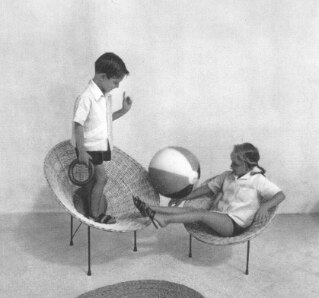
Sahil: G.T.DESIGN's Eco-conscious Design
At Milan Design Week 2025, G.T.DESIGN will showcase Sahil, a jute rug collection by Deanna Comellini. This project masterfully blends sustainability, artisanal craftsmanship, and essential design, drawing inspiration from nomadic cultures and celebrating the inherent beauty of natural materials.
- Sponsored content
The iconic fashion house is celebrating its first century in business this year. For the presentation of the new collection, Alessandro Michele, the brand’s current creative director, spoke about the legacy and “power of the Gucci brand”. However, the history of the Maison began with a young Florentine, Guccio Gucci, born in 1881, the son of artisans with a straw hat workshop. Passionate about fashion, after the First World War, he moved to London as one of the many emigrants in search of fortune, finding employment as an elevator operator in the prestigious Savoy Hotel. And it is from the Savoy, in the meantime reinvented as a night club, that Michele picks up the narrative thread to tell the story of Gucci Aria, recorded in the Cinecittà studios in Rome and co-directed by Floria Sigismondi.
Re-proposing the fashion show in its most canonical elements – catwalk, photographers, models – the fifteen-minute short film launches us into an aseptic dimension but, after a year and more of confinement within the walls of the house, almost chimerical: a white tunnel with walls dotted, like a second skin, with cameras of all kinds and lights.
The challenging goal of this collection was to retrace a dense past but without falling into nostalgia. The catwalk retraces, therefore, the inspirations and cuts that have made the brand famous in the different decades: from equestrian references to Hollywood divas, from distinctive Tom Ford suits – creative director of the brand from 1994 to 2003 –, to the sartorial wisdom until you get to the Balenciaga citation, companion of the Kering stable. These hacked looks appear alongside outfits that embody the Gucci codes: 70s silhouettes, bondage elements, and hints of the equestrian world appear everywhere. Reflecting on the brand’s 100th anniversary, the designer wanted to include aspects of how he envisions “the brand mythology”.

 View gallery
View gallery
But we had already talked about this genealogy of the brand brought forward by Alessandro Michele in the Domus Moda 1014 insert, a couple of years after he was appointed creative director. “A rentless doer and undoer of unheard-of conjunctions and extraordinary interweavings of space, Michele burst onto the stage, from the sidelines at the beginning of 2015, triggering a shockwave that wa felt everywhere, high and low, imposing a new ontology: I adorne therefore I am” writes Angelo Flaccavento. “In his imaginary quivering, Elizabethan drama and Roberta di Camerino, Walter Albini, escapism disco and B-movie, male and female go hand in hand, in a post-modern celebration of collage that glorifies the outcast and the strange. For Michele, creating means swimming in an immense ocean of anti-historical co-presence: his language contemplates repetition because it is a Weltanschauung, firstly a way of being, and secondly fashion.” (Domus 1014, 2017)
Authentic and passionate, he focuses his attention on embellishment and styling, that is, on the assemblage or the look, carrying out an androgynous, mestizo and spurious revolt that undermines the total rigidity of dichotomous thinking at its foundations

We immediately perceive this tendency to undo, to assemble references and quotations: an attempt to reinterpret a rich héritage that is as demanding to represent as it is fundamental and continually inspiring, like an infinite vocabulary of signs and motifs to be reinterpreted and reassembled to tell ever new stories.
Also in Domus 1014 Maria Luisa Frisa goes in search of a relevant and current definition of what fashion is, bringing out the project's centrality in the complex relationship between dress and body. “The body is living matter, it is disobedient, it is subject to the passage of time and together with the restless perception we have of ourselves. Fashion is the tool man has to control it and to make culture out of nature,” writes the critic as well as curator of the Gucci Garden in Florence. “The practice of the creative director – the figure around whom the definition of a fashion project has been built since the Nineties – is similar to that of the curator. It is research, understanding, selection and re-proposition. For the creative director, a project means mapping all the regions that make up his territory of action: iteritage on the one hand, innovation on the other, material quality on the one hand, immediacy of image on the other. I’m thinking of what Alessandro Michele is doing for Gucci, Maria Grazia Chiuri for Dior, Raf Simons for Calvin Klein.” (Domus 1014, 2017)

Even Italo Rota defines the entire brand company as a supply chain with a precise and constant identity. “I don’t know if Alessandro Michele is a genius, but he is certainly a superintelligence, and like all superintelligents he knows, understands, selects and recomposes,” the architect says during an interview. “And this kind of work today is a fundamental operation, much more pertinent than that of a creative genius who wakes up in the morning and makes a sketch. Someone who has very organized thoughts can put together a whole production cycle by sitting at a table, and then immediately come up with mind-blowing results.” (Domus 1014, 2017)
At Gucci, it seems like all the people and internal resources are working together to achieve a common goal
Opening image: Gucci, Fall/Winter 2017. Courtesy Gucci. Originally published on Domus 1014

"The Wings", the triple-certified building of the future
The Wings is an innovative complex that combines futuristic design and sustainability. With BREEAM Excellent, WELL Gold, and DGNB Gold certifications, the building houses offices, a hotel, and common areas, utilizing advanced solutions such as AGC Stopray glass for energy efficiency.
- Sponsored content















































